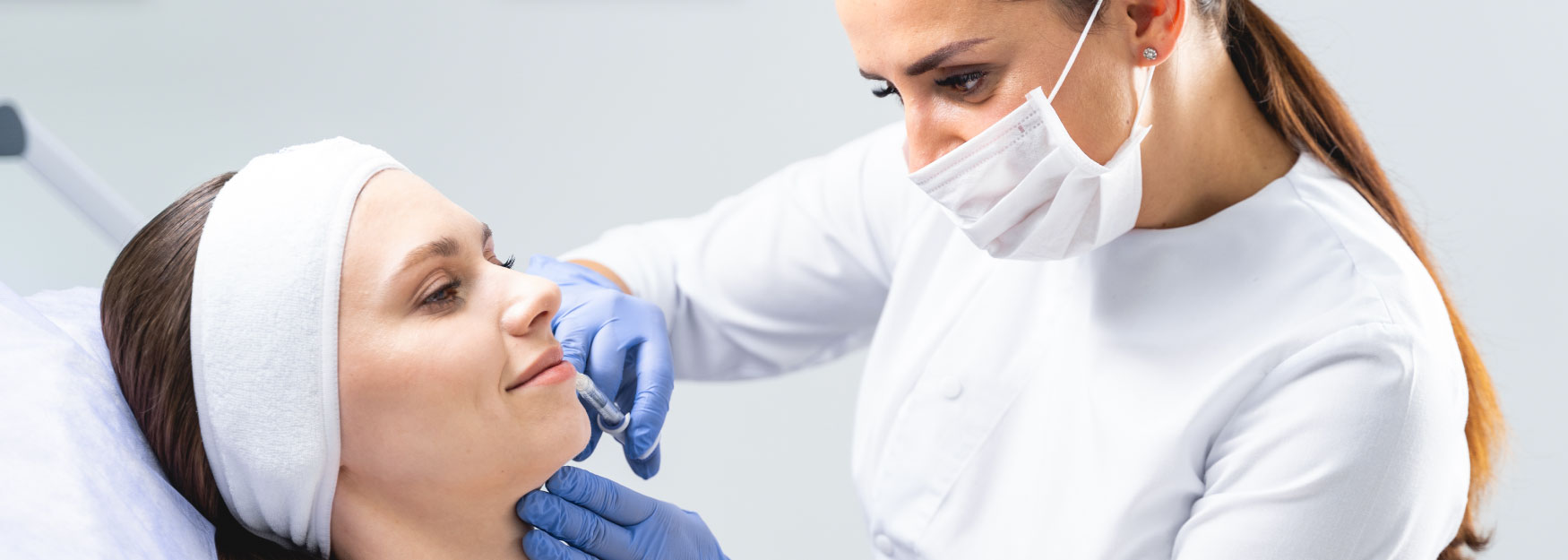
BHRC BLOG
How Many Units of Botox Are Needed for Each Injection Site?
Botox is arguably one of the most flexible cosmetic injections you can get. With a clearly defined mechanism of action, plenty of clinical studies behind it, and even more medical and cosmetic applications, it makes a good case for coming close to being a wonder drug. But you don’t get these effects with any simple anesthetic injection: you need a precise unit count with each botulinum toxin injection to get the desired results.
So how many units are needed for botulinum toxin injections? On average, the total unit count for your botulinum toxin injections will depend on the specific area in which you’re getting the treatment. Knowing how many Botox units are needed is determined by factors like your body’s resistance to Botox, the form of botulinum toxin used, and your age, which all play a role in the procedure’s effectiveness.
Average Unit Dose of Botox per Injection Site
Botox is typically injected in areas prone to lines and wrinkles. Still, since the muscle of each possible injection site may differ, the overall unit count of each injection will also be different. This can also be the case for other patients getting injections in the same area.
Eyebrows: 2 – 5 units
Eyebrow lifts are some of the most common applications for Botox cosmetic treatment since the muscle weakness caused by the drug can quickly achieve lifting effects if injected correctly. Since the area around the eyebrows has a thinner skin patch compared to the rest of the face, providers will usually use a lower unit count to prevent any side effects.
Forehead Lines: 10 – 30 units
Forehead lines use plenty of units per injection site since the facial muscles in the area go through plenty of movement. Horizontal forehead lines, in particular, contribute a lot to your facial expression, which means this area is likely to experience a higher likelihood of the appearance of wrinkles. However, providers will still apply a lower unit count to ensure the active ingredients don’t cause adverse reactions.
Glabellar Lines: 10 – 25 units
Glabellar lines, also known as 11 lines, have complex muscles that involve most of the upper one-third of your face. Because of the complex muscle contraction (and the area’s proximity to your brain), the Botox units used in your treatment will also be on the lower side to avoid abnormal muscle contractions.
Gummy Smile: 2 – 4 units
Similar to the area around the eyebrows, gummy smiles also don’t require a high Botox dose since the effects on the relatively thin skin are enough for the impact that most patients want. Any additional units that the patient may wish to should be cleared with their provider – this goes for any injection in the area, from Lip Flip treatments to lift the corners of the mouth.
Neck Muscles: 25 – 50 units
The neck has far thicker skin compared to most of the sites on the face, and it’s often one of the areas targeted for Botox treatments. Since the wrinkles caused by neck muscles can be more profound than the lines on your face, you’ll often need more Botox in the treated area to relax the muscles. The desired effects you want will be up to the skill of your provider.
Facial Muscles: 15 – 50 units
Areas concentrated for facial contouring, like the masseter muscles, should be evaluated on a case-by-case basis. However, these areas often tolerate a higher Botox dosage than other sites on the face. Because of the complex muscles involved, it may take several treatments for Botox to take effect, especially if the patient is slightly older.
Remember that any complex muscle contraction means that your provider will have to be a little more careful with the number of units they apply to the injected area. Even a slight difference of 1-2 units can have drastic effects on adjacent muscles, so it’s necessary always to be conservative when going for Botox cosmetic treatments.
But why is it so important to stay within these unit counts when going for treatment?
Why Unit Dose Matters for Botox Cosmetic Treatments
First, it’s essential to have a quick understanding of how Botox works. Botox is a brand of botulinum toxin injection (specifically, botulinum toxin type A) that can help manage a variety of cosmetic and medical concerns, from excessive sweating to droopy eyelids and bunny lines.
It stops the release of certain neurotransmitters that control your muscles, which stop most or all muscle movement or contraction in the area. Its effects have gone through plenty of studies, with most Botox treatments having little to no adverse effects.
However, this assumes that these treatments have been appropriately applied, with a skilled provider and the correct number of units used. The reason why units of Botox are limited is that the active ingredient is still a toxin. So too much of it can cause many unwanted effects, from an allergic reaction to respiratory failure.
But keeping track of your Botox units is the best way to ensure you get the desired results without experiencing more than the most common side effects from your treatment.
What Are the Risks of Too Much Botox?
What exactly happens if you get too much Botox? There are several side effects that you can experience, from relatively benign to life-threatening:
Appearance
The first (and usually the only) side effect of incorrect Botox dosage is that your skin will look uneven, lumpy, or even drooping in some places after your treatment. This is usually caused by your muscles relaxing too much because of the high dose of Botox that you got or appearing stiffer if your dose is too low.
Your skin may also appear looser due to the muscle relaxation effects of your Botox treatment, which may make future application of further doses difficult. These effects can be more evident in specific injection sites compared to others. An incorrect Botox dose around your eyes can result in ptosis (a droopy eyelid), while too much Botox around areas on your neck can be relatively unnoticeable.
Botox Migration
Another issue that crops up with incorrect Botox dosage – specifically, if you’ve had too much – is the drug starting to affect areas that it’s not supposed to. This is a side-effect known as Botox migration, where the increased amount of Botox in your system causes the drug to travel to other areas of the body. Some drift of Botox is to be expected with your treatment, but usually only within a 1 to 3-cm allowance.
Botox migration is a cause of concern because its potential complications can be simple to complex. Some patients may only experience relaxed muscles adjacent to the injection site, while more severe cases can have the toxin travel to the brain. Fortunately, this side effect is relatively uncommon.
Botulism Poisoning
An extremely rare but severe side effect of an incorrect Botox dosage can be botulism, which causes breathing difficulties, widespread muscle paralysis, and death. This illness is usually caused by Clostridium botulinum, the bacteria responsible for Botox. However, incorrect doses of Botox can also cause botulism-like symptoms in patients.
This means you must monitor your condition after your Botox treatments, especially if you’re getting them for the first time. While you should trust in the judgment of your Botox provider, your body can still react to the drug unexpectedly. Contact a medical professional immediately if you feel or experience something that’s out of the ordinary after your Botox injection.
When Should I Get Worried?
It’s easy to think that a Botox treatment may be more trouble than it’s worth, especially when something like the number of units can drastically affect the outcome of your treatment. Fortunately, Botox cosmetic treatments have been studied and observed by providers and medical professionals alike, and the consensus is that Botox is safe to use both short and long-term.
That is different from saying that you have no side effects to watch out for. Some of the typical adverse reactions to Botox injections include:
- Prolonged swelling or tenderness at the injection site
- Minor bruising, skin discoloration, and bleeding
- Drooling or loss of fine muscle control
- Fever or chills
- Headaches and slight body pain
However, these side effects don’t last long, generally going away after a few days of bed rest. Patients with bodies that are used to the effects of Botox become less likely to experience any of these side effects over time.
So when should you get worried? If side effects last for more than a week, intensify, or otherwise exhibit behavior that isn’t something that your provider warned you about, consult a doctor immediately. Even if the side effect you’re experiencing is mild if it’s not something your provider has been briefed on, get yourself checked as soon as possible.
How Do I Avoid Botox Overdose?
Given all of these concerns, what’s the best way for patients to avoid incorrect doses of Botox? The best way to prevent potential adverse effects with Botox treatments is to find an experienced provider.
An experienced Botox injector is someone familiar with using Botox for cosmetic treatments and a professional who understands the unique demands of using this type of injectable. Correctly injecting Botox can sometimes be more art than science for many patients. Given that every person has slightly different facial anatomies, finding an experienced provider is crucial for getting the outcome you want.
An experienced Botox provider won’t only ensure that you get the correct dose of Botox with your treatments but can also account for any changes that need to be made over time. People who start Botox treatments early will often have different doses compared to someone who began their treatments late – and keeping track of these changes is essential to prevent any serious complications from happening.
Partnering with an experienced Botox provider also ensures that your results will stay long-term. As your doses change as you get older (or need more of it across different injection sites), your provider must clearly know how much Botox is required for the outcome you want. This allows them to make a personalized treatment plan to ensure that you get the best results from your injections while avoiding most side effects.
Safe and Effective Botox Injections and Other Cosmetic Treatments With Beverly Hills Rejuvenation Center
Being careful about the unit count of your Botox injections keeps you safe from adverse effects while ensuring that it works as intended to eliminate wrinkles and other fine lines on the face. If you need more clarification about the total number of units required for your treatment, you should trust your provider’s study about the ideal number of units per injection site. With an experienced provider, your Botox cosmetic procedure can become an effective treatment for the signs of aging.
Beverly Hills Rejuvenation Center has plenty of experience using botulinum toxin products for cosmetic injections, helping our clients get rid of frown lines, forehead lines, and facial wrinkles with minimal to no adverse reactions. As experts in non-invasive cosmetic treatments, our application of Botox injections has been trusted by celebrities and regular clients, with high patient satisfaction rates each time. Please schedule a consultation today for more information about our different treatment options.






